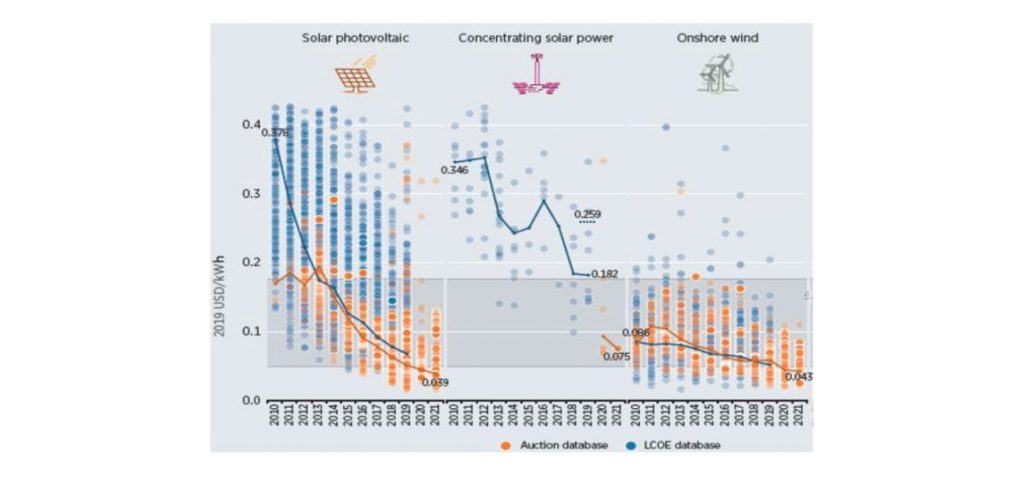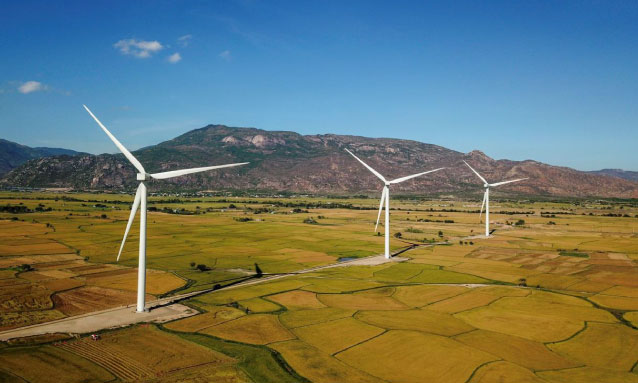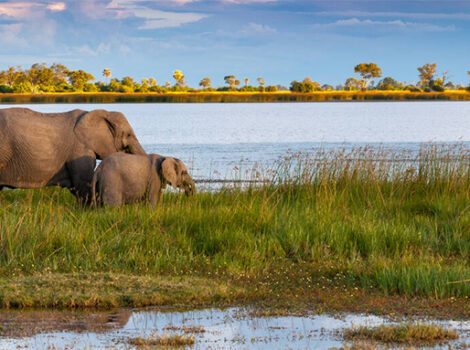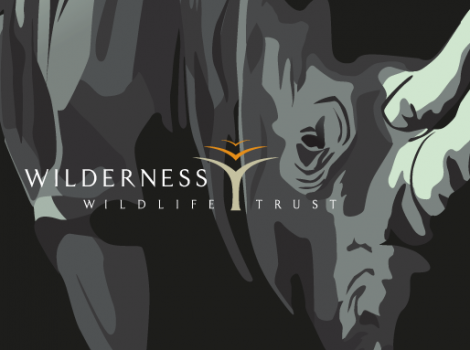As the Coronavirus continues to take its toll on global economies, the pandemic is exposing all manner of deficiencies across many sectors. Globally, the COVID-19 crisis has highlighted the importance for countries to become more self-sufficient particularly related to food and energy security. According to the International Renewable Energy Agency (IRENA), solar photovoltaic and wind energies are now the cheapest sources for electricity generation at a price even cheaper than coal-generated electricity1.
With its immense solar irradiation and significant wind resource in some parts of the country, Botswana could quickly increase the amount of electricity locally produced through the development of renewable energy.

Evolution of Cost of Energy in USD/Kwh over last 10 years (IRENA Renewable Cost of energy Database 2019 – variation of LCOE depending on project size, local regulations, PPA terms & conditions, country & off-taker economic aspects). Given the recent improvement of the technology, Solar and Wind energy are now among the cheapest sources to produce electricity, which can commit on 20/25 years flat tariff with no variable fuel component, no water requirement and with no carbon emissions financial liability2.
The Botswana perspective
It is no secret that Botswana has relied on imported electricity for a significant portion of its history particularly from South Africa’s, Eskom. Local generation would reduce the reliance on importation of electricity and could even flip the tables by exporting electricity to bridge the SADC region deficit, contributing positively to Botswana’s trade balance. As such, Botswana could become the RENEWABLE ENERGY HUB of Southern Africa supplying cheap electricity to its people and enhancing economic growth and development. This would make complete sense for a country which has made a major impact with Eco-Tourism and conservation internationally.
Large projects with direct local employment can be implemented in a relatively short term (1-2 years for Solar, 3-4 years for Wind) and be scaled up quickly. Being environmentally friendly with no carbon emissions, this would also attract investment by allowing the local and international companies to install their manufacturing facilities in Botswana. The companies would also need to commit with their Carbon Neutral operation policies3 as well as creating new skilled jobs and local value chain. This would ideally be from the mining pit to the end product (like a battery mega-factory given the ideal location of Botswana, with most of the components mined locally or in nearby countries4).
The economic benefits would help mitigate against the COVID-19 economic impact on the tourism industry while water resource could be mainly focused towards agriculture, as it may become more scarce in the future due to the impact of climate change.

Figures from the IPCC report5: (Left) modelled increase of temperature depending on scenarios, showing “2 degrees increase over 1850 level” is predicted to be reached before 2050 as most long-term investments (coal/fossil fuel Power Plant & transport road/sea/air) will not be decommissioned for another 20-30years. (Right) worldwide modelled impact on temperature and precipitation for 2 different scenarios (RCP 2.6 – quite conservative but already showing 1.5 to 2ºC increase over Southern Africa and RCP8.5 – more pessimistic, although not unrealistic where the temperature could increase by up to 6 degrees in the region). In both cases, it tends to show less precipitation, leading to a dryer and hotter Botswana/southern Africa in the future. With nearly no water requirements for solar and wind energy, water could be focused on agriculture as well as on industrial and mining activities.
On the top of that, Botswana could further reduce its carbon footprint by implementing an incentive program on Solar Rooftop and Solar Thermal installation, which could also quickly create countless skilled jobs across the country and move towards meeting carbon emission targets.
In short, an ambitious plan in renewable energy development could not only contribute to the ERTP (Economic Recovery and Transformation Plan) with jobs and investments but also help Botswana to comply with its Paris agreement commitment to fight climate change. The time has come to embrace the Blue Energy revolution and position Botswana as a top innovative, carbon-free tourist and investment destination.
BIUST and Solar Industries Association of Botswana (SIAB) are ready to support the local renewable sector – UB, BIUST and all the relevant authorities and stakeholders to kick start this new Blue Vision.

Further information:
1) See IRENA report and website: http://www.irena.org/newsroom/pressreleases/2020/Jun/Renewables-Increasingly-Beat-Even- Cheapest-Coal-Competitors-on-Cost
2) To reduce carbon emissions, many countries (like South Africa) are now implementing a Carton Tax on CO2 emissions and the IMF has recommended a price to reach 75USD/tCO2 by 2030 to limit temperature increase to 2oC, which would add about 6¢USD/Kwh to the cost of Coal Electricity. That could significantly affect Botswana, whose electricity is mainly based on coal either through its local generation plants or import from South Africa. (http://www.imf.org/external/pubs/ft/fandd/2019/12/the-case-for-carbon-taxation-and-putting-a-price-on-pollution- parry.htm)
3) A lot of international groups are now engaged in Carbon Neutral policies to be reached by 2030 to 2050. Microsoft wants even to be “carbon negative” by 2040. http://www.forbes.com/sites/blakemorgan/2019/08/26/101-companies-committed-to-reducing-their-carbon-footprint/#783d7762260b and http://www.vox.com/the-goods/2020/3/5/21155020/companies-carbon-neutral-climate-positive see also http://youtu.be/wj0UrF2T130
4) With ambitious targets on renewable energy sources and cheap carbon-free electricity, it could bring some manufacturing in solar components (like invertors and solar thermal geyser). Also, by facilitating the local transformation of mining resources, Botswana could become a leading country in manufacturing from mining pit to end products (such as copper plumbing pipes, power cables or even whole electric motor to surf on the increasing demand for EV (Electric Vehicle) and even battery storage manufacturing – see the example of RSA and Australia. http://cleantechnica.com/2020/02/09/new-south-african-lithium-ion-cell-mega-factory-plans-for-32-gwh-year-by-2028/ and http://www.austrade.gov.au/ArticleDocuments/5572/Lithium-Ion%20Battery%20Value%20Chain%20report.pdf.aspx)
5) A hotter and dryer climate could impact wildlife and tourism in Botswana in a significant way. See IPCC report: http://ar5-syr.ipcc.ch/topic_summary.php. See also http://www.ipcc.ch/sr15/chapter/chapter-3/ (section on Sub-Saharan Africa) and also http://hess.copernicus.org/articles/15/279/2011/hess-15-279-2011.pdf
About the authors:
Gilles Beau is a Mechanical and Electrical Engineer with over 12 years’ experience in wind energy in Vietnam, Cambodia and Thailand, among others. Beau recently arrived in Botswana and is keen to contribute to the development of wind energy in the country. Gilles is an expert in Wind Energy Project Development, Climate Change and Water Saving.
Karen Gibson, BEng in Electrical Engineering is the owner of So Solar (Pty) Ltd and Secretary at Solar Industries Association Botswana. Her passion lies in finding creative solutions to plugging the ‘gaps’ in the industry and assisting in creating an enabling environment for renewable installations.
With a PhD in Solar technology, Tobias Bader is a Lecturer at BIUST, heading the Department of Mechanical, Energy and Industrial Engineering.



